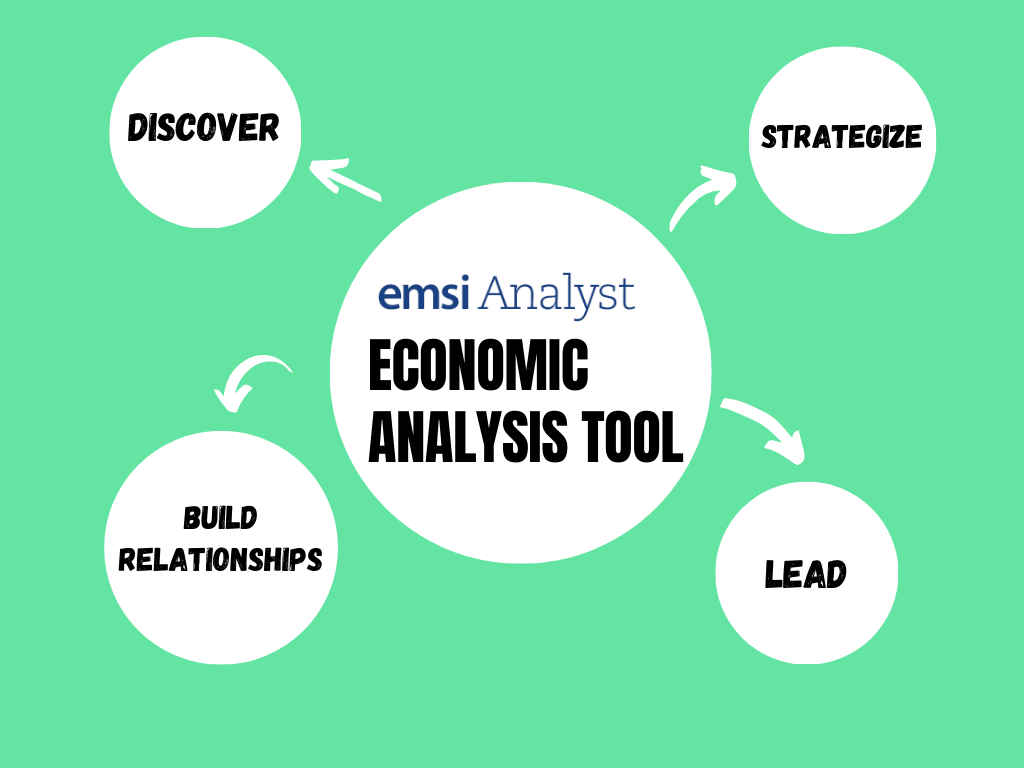Analyst is an online tool that pulls data from a range of sources to provide information on regional economies and workforces. Clients can use Analyst to understand the demand for educational programs, identify the skills that employers need, communicate the value of higher education to parents and students, connect jobseekers to the labor market, find the right talent, and so much more.
But, over time, a common pattern has emerged. No matter the use or application, almost every client uses Analyst to do the following:
- Discover
- Strategize
- Lead
- Build relationships
Discover
First, clients use data to discover the world around them, sense new trends, growing industries, in-demand occupations, emerging skills, and more.
Essentially, the first step is simply to know and clients can use Analyst to get the facts.
Examples:
- Talent acquisition – analyzing competition in the job market to make a more informed decision on whether to acquire talent internally or externally.
- Helping students and jobseekers – bringing awareness to career opportunities to make the most out of their educational investment.
- Measuring impact – using data to measure the economic importance and prove the positive impact a proposed business development project would have on a community.
Strategize
Once clients discover the facts, they strategize. They identify an opportunity and consider how to direct their limited time, resources, and people to what matters most, then plan how best to address that need.
Examples:
- Recruiting – conducting a national/provincial scan to discover high concentration of sales talent in a certain region. Thus, building a recruiting strategy targeting this area to attract more attention from solid candidates.
- Educational alignment – completing an environmental scan and survey of the local economy, a university confirms the pervasive need for more data science and analytics skills to align with employer needs.
- Workforce development – A local workforce development board performs a gap analysis and discovers that local delivery is one of the more promising areas of opportunity for a host of local restaurants and hospitality workers who will not likely regain their former jobs. Thus, the workforce board develops a plan to work with a local training provider and a set of companies to quickly transition dislocated workers into these new delivery roles.
Lead
Leadership, one of the top skills for 2021, is invaluable in both individuals and organizations. As clients know and strategize, they become leaders in whatever problem they solve. They do their homework, figure out the steps to solve the problem, and then get to work doing it. They don’t wait on others to act. They act as catalysts for their communities.
When clients lead with data, they attract followers.
- Higher education – Colleges and universities gain a reputation for being relevant, developing programs that quickly address actual needs in the real world.
- Communities – Workforce professionals and economic developers gain a seat at the table for all types of problems. Companies, colleges, and other community-based organizations naturally tap these groups first whenever they see a need.
- Employers – Companies use their HR teams to find data-driven solutions for all manner of internal problems.
Build relationships
The net result of working with data are strong relationships.
Clients use data to build relationships inside and outside of their organization. As they discover, strategize, and lead, they find themselves in the unique position of being trusted and sought after. They are recognized as effective and helpful, and they are known for adding value to others.
Examples:
- Building relationships between colleges and employers – A college president sets up a meeting with the CEO of a large local employer. To prepare for this meeting, the president collects data on two key points: 1) the number of graduates who now work at this company, and 2) how the skills taught in their institution’s programs align with the employer’s own job postings. During the meeting, the president shows the CEO this data and realizes the college is a significant contributor to the organization’s current (and future) workforce.
- Creating an emerging workforce – A local economic development organization meets with an agricultural industry association that is struggling to find a new generation of young people to work in the regions’ many agricultural practices. The economic developer uses data and testimony from the local association to work with the college to build a new program. As a result, the college, industry association, and economic developer form a strong bond to develop the industry and create an emerging workforce for these jobs.
- Developing new programs that fill talent gaps – A large company uses data to discover that many workers laid off within travel and hospitality could fairly easily transfer to sales and customer service. Thanks to their background, these workers already have many of the sales and CS skills necessary for the job. So the business works together with a local college to craft courses that will help these workers move seamlessly into high-paying, in-demand new jobs.
Conclusion
Discover. Strategize. Lead. Build relationships. The whole point of using data is to connect people, education, and work—all in the context of specific communities. This makes our economy and our regions stronger. It’s a win for you because you are in a position of value to other people, and it’s clearly a big win for the people you help, because they can’t get where they need to be without you.
Analyst is a product developed by EMSI and delivered in partnership with by the Ontario Ministry of Agriculture, Food, and Rural Affairs (OMAFRA) to help you better understand your region so you can make more informed decisions. Visit Analyst: economic analysis software | Ontario.ca for more information on how to request access to your 30-day Analyst account.
For the full original blog, please visit 4 Ways Our Clients Use Emsi Data – Emsi (economicmodeling.com).

Leave a ReplyCancel reply